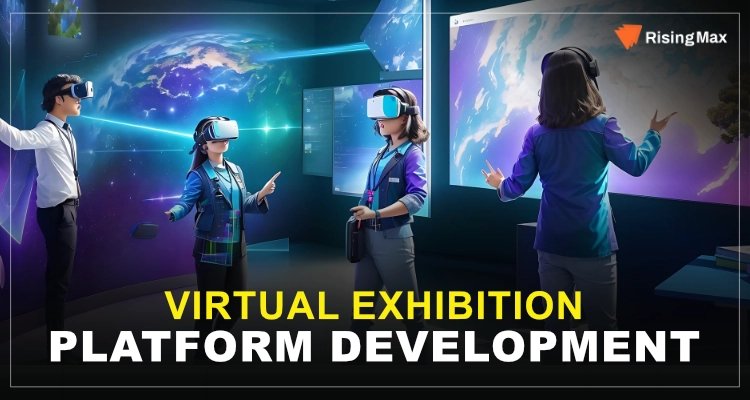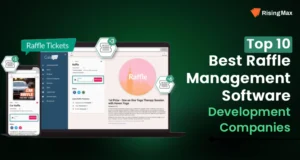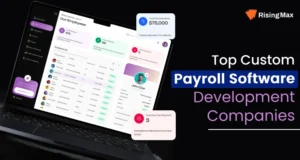The emergence of virtual exhibition platforms has revolutionized the way we experience art, culture, and commerce. In a rapidly evolving digital landscape, these platforms provide immersive and accessible avenues for individuals and businesses to showcase their products, artworks, and ideas to a global audience.

The development of a virtual exhibition platform encompasses a blend of cutting-edge technologies such as virtual reality (VR), augmented reality (AR), and 3D modeling, enabling users to explore virtual galleries, attend conferences, and interact with exhibits from the comfort of their homes. This introduction delves into the transformative potential of virtual exhibition platforms, exploring their role in democratizing access to culture and commerce while highlighting the exciting possibilities they offer for creators and audiences alike.
Partner with RisingMax Inc. to create your bespoke virtual exhibition platform. Elevate attendee engagement and maximize ROI.
What Is Virtual Exhibition Platform?
A virtual exhibition platform is a digital environment designed to replicate the experience of attending a physical exhibition or trade show in a virtual space. It leverages advanced technologies such as virtual reality (VR), augmented reality (AR), and 3D modeling to create immersive and interactive environments. Users can explore virtual galleries, interact with exhibits, and engage with content, all from the convenience of their computers or VR headsets.
These platforms serve many purposes, from showcasing art and cultural exhibitions to facilitating virtual product launches, conferences, and trade expos. They enable exhibitors to reach a global audience without the constraints of physical location, making it an invaluable tool for businesses, artists, and organizations looking to expand their reach and engagement.
Virtual exhibition platforms offer a dynamic and inclusive approach to experiencing exhibitions, breaking down geographical barriers and enhancing accessibility. They are at the forefront of digital transformation, offering a glimpse into the future of events, commerce, and cultural dissemination.
Also Read: How To Set Up A Conference Meeting/Room In Metaverse
9 Business Benefits Of Virtual Exhibition Platform Development
Global Reach
Virtual exhibition platforms enable businesses to reach a global audience without the constraints of physical location, allowing for broader market penetration.
Cost Savings
Hosting virtual exhibitions eliminates the need for expensive venue rentals, travel expenses, and physical booth construction, resulting in significant cost savings.
24/7 Accessibility
Virtual exhibitions are accessible around the clock, accommodating attendees from different time zones and schedules, ensuring continuous engagement.
Data Analytics
These platforms provide valuable data on attendee behavior, interests, and engagement levels, allowing businesses to tailor their marketing strategies and product offerings.
Reduced Environmental Impact
By reducing the need for physical travel and printed materials, virtual exhibitions contribute to a company’s sustainability goals and reduce its carbon footprint.
Expanded Networking Opportunities
Attendees can easily connect with exhibitors, partners, and other attendees through chat rooms, webinars, and virtual meetings, fostering valuable business relationships.
Content Flexibility
Virtual platforms offer flexibility in presenting content, including multimedia presentations, product demos, and interactive simulations, enhancing the effectiveness of communication.
Lead Generation
Exhibitors can collect leads and contact information digitally, streamlining the lead generation process and enabling immediate follow-up after the event.
Cost-Effective Sponsorship Opportunities
Virtual exhibitions provide affordable sponsorship packages, attracting a wider range of sponsors and partners, which can help cover event costs and generate additional revenue.
These benefits make virtual exhibition platform development a strategic choice for businesses looking to expand their reach, reduce costs, and enhance their overall marketing and networking efforts.
Business Centric Features Of Virtual Exhibition Platform
Virtual exhibition platforms are becoming increasingly popular in the business world, offering a wide range of features to enhance the experience for both exhibitors and attendees. Here are nine business-centric features of virtual exhibition platforms:
Customizable Booths
Virtual exhibition platforms allow businesses to create and design their virtual booths to reflect their branding and showcase their products or services effectively. This customization helps in creating a unique and immersive experience for attendees.
Lead Generation Tools
These platforms often include lead capture forms, chatbots, and interactive features that enable exhibitors to collect valuable attendee information, such as contact details and interests, for follow-up and lead nurturing.
Analytics and Reporting
Businesses can access real-time analytics and reporting tools to track visitor engagement, booth traffic, and attendee behavior. This data helps exhibitors measure their ROI and make informed decisions for future exhibitions.
Networking and Engagement Features
Virtual exhibition platforms offer various networking opportunities, such as one-on-one video meetings, group chats, and discussion forums, allowing businesses to connect with potential clients, partners, and industry peers.
Content Sharing
Exhibitors can share a wide range of content, including product videos, brochures, whitepapers, and live presentations, to educate and engage attendees about their offerings.
Virtual Auditoriums
Some platforms include virtual auditoriums or webinar features where businesses can host live presentations, panel discussions, and keynote speeches to showcase thought leadership and industry expertise.
Interactive Product Demos
Virtual exhibitions often include interactive product demonstrations, 3D models, and augmented reality (AR) features that allow attendees to explore products and services in a hands-on virtual environment.
E-commerce Integration
Many virtual exhibition platforms support e-commerce functionality, enabling exhibitors to sell products or services directly from their virtual booths, streamlining the buying process for attendees.
Global Reach
Virtual exhibitions eliminate geographical barriers, allowing businesses to reach a global audience without the need for physical travel. This expanded reach can lead to increased brand visibility and access to new markets.
These business-centric features make virtual exhibition platforms a powerful tool for companies looking to showcase their products, generate leads, and network within their industry while adapting to the changing landscape of business events.
Must Have Features Of Virtual Exhibition Platform For Users
Virtual exhibition platforms are designed with the user experience in mind to make attending online exhibitions engaging and informative. Here are six user-centric features of virtual exhibition platforms:
User-Friendly Navigation
Virtual exhibition platforms prioritize ease of navigation with intuitive interfaces. Users can explore the virtual event easily, find exhibitor booths, access content, and engage in activities without technical difficulties.
Interactive 3D Environment
Many virtual exhibition platforms create immersive 3D environments that allow users to explore the virtual event space as if they were physically present. This provides a sense of immersion and engagement.
Personalized Content Recommendations
These platforms often employ algorithms to suggest relevant exhibitors, sessions, and content based on user profiles and interests. This personalization helps attendees discover valuable information and connections.
Multi-Platform Accessibility
Virtual exhibition platforms are designed to be accessible across various devices, including desktop computers, tablets, and smartphones. Users can participate in exhibitions from anywhere with an internet connection.
Engagement Tools
To keep users engaged, virtual exhibition platforms offer interactive features like live chats, Q&A sessions, polls, and gamification elements. These tools enhance the overall user experience and foster interaction with exhibitors and other attendees.
Accessible Content Library
Virtual exhibitions often provide a content library where users can access on-demand presentations, webinars, and other resources even after the live event has ended. This feature allows attendees to revisit content and continue learning.
These user-centric features aim to replicate the experience of attending a physical exhibition while providing additional benefits and convenience. They enhance engagement, learning, and networking opportunities for attendees, making virtual exhibition platforms a valuable tool for both event organizers and participants.
Experience the Future of Exhibitions with RisingMax Inc.!
Hire us in shaping the virtual exhibition landscape. Connect with our experts to develop a cutting-edge virtual exhibition platform tailored to your needs. Let’s redefine events together!
Virtual Exhibition Platform Development Procedure
Developing a virtual exhibition platform involves several steps to create a user-friendly and feature-rich environment for exhibitors and attendees. Here is a simplified outline of the development procedure in six steps:
Planning and Conceptualization
– Define the purpose and goals of the virtual exhibition platform.
– Identify your target audience and their needs.
– Outline the key features and functionalities you want to include.
– Create a project plan, including timelines and budget estimates.
Design and User Experience (UX)
– Develop wireframes and prototypes to visualize the platform’s layout and user interface.
– Focus on user-centric design principles to ensure an intuitive and engaging experience.
– Incorporate 3D elements or an immersive environment if required.
– Create a design style guide to maintain consistency throughout the platform.
Development
– Choose the appropriate technology stack for your platform, considering factors like scalability and security.
– Develop the platform’s core functionality, including user registration, exhibitor booth creation, and content management.
– Implement features such as interactive 3D spaces, chat functionality, content sharing, and e-commerce integration.
– Ensure robust security measures to protect user data and privacy.
Testing And Quality Assurance
– Conduct rigorous testing to identify and rectify bugs, glitches, and usability issues.
– Perform load testing to ensure the platform can handle a large number of simultaneous users.
– Test the platform on various devices and browsers to ensure cross-compatibility.
– Implement feedback from user testing to enhance the platform’s usability and performance.
Content And Exhibitor Onboarding
– Develop a content management system (CMS) for exhibitors to upload and manage their content, such as product images, videos, and documents.
– Create guidelines and support for exhibitors to set up their virtual booths effectively.
– Offer training or tutorials to help exhibitors maximize their presence on the platform.
Launch And Marketing
– Announce the platform’s launch date and promote it through various marketing channels, including social media, email campaigns, and partnerships.
– Host a launch event or webinar to introduce the platform to potential exhibitors and attendees.
– Monitor the platform’s performance during the event and address any issues that arise in real-time.
– Gather feedback from exhibitors and attendees to make improvements for future virtual exhibitions.
After the initial launch, continue to iterate and improve the platform based on user feedback and evolving technology trends to ensure its long-term success and relevance in the virtual exhibition industry.
Also Read: Virtual Awards Ceremony Platform
FAQs
Certainly! Here are four frequently asked questions (FAQs) related to the development of virtual exhibition platforms:
What are the key technologies used in developing virtual exhibition platforms?
Virtual exhibition platforms often leverage a combination of technologies, including web development frameworks (e.g., React, Angular, or Vue.js), 3D rendering engines, virtual reality (VR) or augmented reality (AR) capabilities, cloud infrastructure (e.g., AWS or Azure), and video conferencing APIs (e.g., Zoom or WebRTC). The choice of technologies depends on the platform’s specific requirements and features.
How do you ensure the security and privacy of user data in virtual exhibition platforms?
Security is a paramount concern in virtual exhibition platforms. Developers implement encryption protocols (e.g., HTTPS) for data transmission, secure user authentication and authorization mechanisms, regular security audits, and compliance with data protection regulations (e.g., GDPR or CCPA). Additionally, robust access controls and user consent mechanisms are integrated to safeguard user data and privacy.
What challenges are commonly encountered during virtual exhibition platform development?
Some common challenges include optimizing the platform for a smooth and immersive user experience, managing heavy traffic loads during peak usage times, ensuring cross-browser and cross-device compatibility, and developing effective content management systems for exhibitors. Moreover, striking a balance between features and performance can be challenging, especially when incorporating 3D elements and real-time interactions.
How do you handle scalability for virtual exhibition platforms during large events?
Scalability is a critical consideration for virtual exhibition platforms, particularly during high-traffic events. Developers often employ cloud-based infrastructure that can dynamically scale resources as needed. Load balancing techniques distribute traffic efficiently, and content delivery networks (CDNs) help reduce latency. Continuous load testing and performance optimization are essential to ensure the platform can handle large volumes of concurrent users without degradation in performance.
Conclusion
RisingMax Inc. stands as a pioneering force in virtual exhibition platform development. With a commitment to innovation, user-centric design, and cutting-edge technologies, RisingMax Inc. has consistently delivered exceptional virtual exhibition solutions. Our dedication to security, scalability, and immersive experiences has propelled us to the forefront of this dynamic industry. As a trusted partner, RisingMax Inc. continues to empower businesses to adapt and thrive in the virtual exhibition landscape. With a bright future ahead, they remain poised to shape the way we connect, showcase, and engage in the virtual world.












